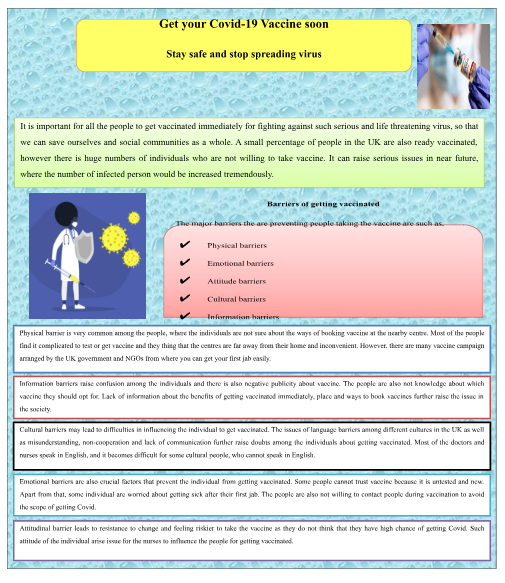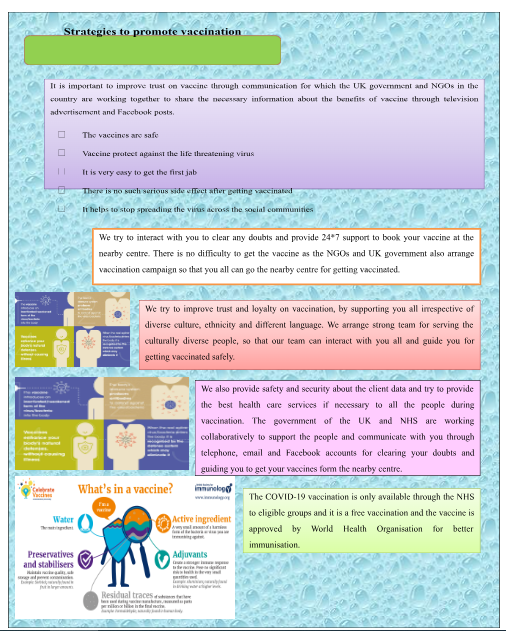Business Communication Covid-19 Vaccination
Advertising campaign


Analysing communication for promoting vaccine
Introduction
Organisational communication is the practice of interacting with the stakeholders, engaged with the firm as well as share the information for working collaboratively. In the recent era of globalisation, the organisations try to enhance the internal and external communication, in order to communicate with others, develop strong bonding and create good stakeholders base for leading the organisations towards achieving the aim (Petersen et al., 2021). The study helps to explore the communication practices of the government of the UK, NHS and other NGOs to share the information about vaccination, so that the people are concerned about getting their first jab as soon as possible. There are several barriers among the people that prevent them to take vaccine, which will be discussed in this paper. Additionally, the strategies of enhancing communication would be proposed, so that the government and health care organisation can cooperatively raise awareness among the social communities to influence the people for taking their vaccines immediately. Those seeking healthcare dissertation help can gain valuable insights from such communication strategies.

Organisational communication
Organisational communication is important for enhancing internal interaction and cooperation among the individuals, and it is important for the organisational staff and managers to share all the necessary information and data with the stakeholders for better performance. There are several ways of enhancing communication among the stakeholders, which are verbal communication, written communication as well as formal and informal communication, through which the organisational management team aim at enhancing interaction among the individuals working in the workplace (Rzymski et al., 2021). In case of raising awareness for taking vaccination, communication plays a crucial role to improve trust and bonding among the social communities across the UK. It improves engagement with the communities irrespective of cultural diversity and language gap. It strengthens the relationship among the people where the individuals can acknowledge adequate information and data related to Covid 19, so that they can understand the activities and necessity of getting vaccinated. It is defined as the channel and forms of communication that occur within the company, such as corporations, NGOs and government bodies for enhancing internal and external communication (Chou and Budenz, 2020). Verbal communication is important at the organisational context to convey the messages and clear the doubts of the service users in the society. One to one communication is preferred by the organisational representative to build bonding and improve understanding about the available services and quality of the services that would be beneficial for the users.
On the other hand, non-verbal communication includes eye contact, body language, gestures and postures, facial expression and physical contact, where it would be beneficial for the organisational representatives to develop non-verbal communication for sharing the information and improving understanding for retaining the users. Formal and informal communication is also important in the organisational context to share the information with the stakeholders for better practices (Gold et al., 2019). There are several ways of developing formal communication such as sending email and letters to the services users and employees, developing blogs and notice board. Through rearing presentations, Facebook posts and sharing organisational information through official website of the organisation as well as arranging conferences are also other forms of formal communication, which are structured well to convey the adequate information and important data to the stakeholders, engaged with the services (Gesualdo et al., 2021). On the other hand, there are informal communication, which are not structured and planned previously such as telephonic conversation, group discussion, interaction sessions and face to face conversation. This informal communication practice is beneficial for enhancing internal and external organisational communication to engage with the stakeholders and services users. For conveying the message related to the vaccination campaign, it is essential to develop good communication strategy and arrange advertisement and campaign to influence the social communities of the UK irrespective of diverse culture and different language (Atkinson et al., 2020).
Evaluate the barriers of communication preventing people getting the vaccine
There are several barriers for which the individuals are not willing to take their vaccine immediately and the barriers are related to physical barriers, emotional, cultural, and attitudinal and information barriers. The physical barriers are crucial where the people are unsure about the vaccine, its quality and effectiveness. The people also think that they suffer during vaccination and these are inconvenient to get to. There is lack of information for which doubts arose among the individuals mainly the culturally diverse people such as minority group and Black people in the UK. Emotional barriers are also related to this, where the people are scared to get vaccinated and they are worried about the afterward effects of vaccine including body pain, getting sick or fever (Jin et al., 2021). They try to avoid the contact with people during vaccination and are willing to stay home without getting vaccinated. Information barrier is a serious issue, for which the individuals are not concerned about the importance of vaccine arrange by the NHS with collaboration of the UK government and NGOs. There is also negative publicity of media and negative attitude among the people to not to get their vaccine. There is attitudinal issues, such as resistance to change and lack of willingness to get vaccinated as they thing it is riskier to get vaccine (Costantino et al., 2019). Cultural barriers also exists, where lots of people in the UK are not confident with the positive impacts of vaccine as well as some of the people cannot speak in English and they feel hesitated to interact with doctors and nurses for language gap. It is hereby important to develop good communication strategy for successful promotion of the vaccine so that, positive publicity can be possible and it would be benefitted to the social communities for getting their vaccine immediately.
Outline government strategies to overcome these barriers
Through arranging vaccination campaign at different market place in the UK, it is important to announce the importance of vaccination, in order to raise awareness among the people. The messages must be conveyed to the individuals and the important information related to vaccine are such as the vaccines are safe, vaccine protect against the life threatening virus, it is very easy to get the first jab, it also helps to stop spreading the virus across the social communities and there is no such serious side effect after getting vaccinated.
Developing social media campaign through utilising Facebook page of the government and NHS would be designed for conveying the message that the COVID-19 vaccination is only available through the NHS UK and it is a free vaccination, approved by World Health Organisation for better immunisation.
The government of the UK and NHS must work collaboratively to support the people and communicate with you through 24*7 telephone services, email services and Facebook accounts for clearing their doubts and guiding them to get vaccines form the nearby centre.
It is important to update the official website of the NHS, in order to support the individuals across the UK, where the people can access their website and understand all the necessary information related to the vaccination.
Television advertisement is mandatory for raising awareness among the individuals across the UK, where the NHS and government of UK must cooperate with each other and contribute in advertisement for sharing the messages rated to vaccination and influence the people to get their vaccines immediately to stop spreading virus.
NHS Twitter account is active and the people follow the hash tags for better information gathering and accessing all the necessary information for improving lifestyle and maximising their wellbeing. NHS must utilise the Twitter account and continuous update the availability of vaccine at the nearby centres so that the people can get their vaccine easily.
Evaluating communication practices
The above mentioned proposed strategy for enhancing communication across the UK is beneficial to increase the percentage of people getting vaccinated. The social media advertisement such as Facebook and twitter would be best strategy for the NHS and government of the UK to raise awareness and share all the necessary information through daily updates, for influencing the people to get their first jab as soon as possible (Peretti-Watel et al., 2020). Additionally, this enhances the market communication through commenting on the social media posts and gets their reply for clearing doubts, where the NHS staffs provides guidance and support to the people for better access of the vaccines. On the other hand, the official website is also there with telephone numbers and email address, where the people can contact the representatives of the NHS for getting adequate information related to vaccine (Bagcchi, 2021). These are effective ways to raise concern among the social communities and cooperate with them for better bonding and trust.

Conclusion
It can be concluded that, the television advertisement as well as social media campaign and advertisement are effective for the NHS to raise awareness among the social communities irrespective of cultural diversity, on the other hand, arranging campaign at different social communities are also effective to influence the people, share important and true information about vaccine and support the to get vaccine immediately at the nearby centre to fight against such life threatening virus cooperatively. Enhancing communication in this context is helpful to engage the people with the vaccination campaign and increase the percentage of people getting vaccinated as soon as possible with continuous cooperation, support and guidance.
Dig deeper into Business Analysis & Planning with our selection of articles.
Reference List
Atkinson, K.M., Mithani, S.S., Bell, C., Rubens-Augustson, T. and Wilson, K., 2020. The digital immunization system of the future: imagining a patient-centric, interoperable immunization information system. Therapeutic Advances in Vaccines and Immunotherapy, 8, p.2515135520967203.
Bagcchi, S., 2021. The world's largest COVID-19 vaccination campaign. The Lancet. Infectious Diseases, 21(3), p.323.
Chou, W.Y.S. and Budenz, A., 2020. Considering emotion in COVID-19 vaccine communication: addressing vaccine hesitancy and fostering vaccine confidence. Health communication, 35(14), pp.1718-1722.
Costantino, C., Restivo, V., Gaglio, V., Lanza, G.L.M., Marotta, C., Maida, C.M., Mazzucco, W., Casuccio, A., Torregrossa, M.V. and Vitale, F., 2019. Effectiveness of an educational intervention on seasonal influenza vaccination campaign adherence among healthcare workers of the Palermo University Hospital, Italy. Ann Ig, 31(1), pp.35-44.
Gesualdo, F., Bucci, L.M., Rizzo, C. and Tozzi, A.E., 2021. Digital tools, multidisciplinarity and innovation for communicating vaccine safety in the COVID-19 era. Human Vaccines & Immunotherapeutics, pp.1-4.
Gold, R.S., Auld, M.E., Abroms, L.C., Smyser, J., Yom-Tov, E. and Allegrante, J.P., 2019. Digital Health Communication Common Agenda 2.0: An updated consensus for the public and private sectors to advance public health. Health Education & Behavior, 46(2_suppl), pp.124S-128S.
Jin, Q., Raza, S.H., Yousaf, M., Zaman, U. and Siang, J.M.L.D., 2021. Can Communication Strategies Combat COVID-19 Vaccine Hesitancy with Trade-Off between Public Service Messages and Public Skepticism? Experimental Evidence from Pakistan. Vaccines, 9(7), p.757.
Peretti-Watel, P., Seror, V., Cortaredona, S., Launay, O., Raude, J., Verger, P., Fressard, L., Beck, F., Legleye, S., l'Haridon, O. and Léger, D., 2020. A future vaccination campaign against COVID-19 at risk of vaccine hesitancy and politicisation. The Lancet Infectious Diseases, 20(7), pp.769-770.
Petersen, M.B., Bor, A., Jørgensen, F. and Lindholt, M.F., 2021. Transparent communication about negative features of COVID-19 vaccines decreases acceptance but increases trust. Proceedings of the National Academy of Sciences, 118(29).
Rzymski, P., Borkowski, L., Drąg, M., Flisiak, R., Jemielity, J., Krajewski, J., Mastalerz-Migas, A., Matyja, A., Pyrć, K., Simon, K. and Sutkowski, M., 2021. The strategies to support the COVID-19 vaccination with evidence-based communication and tackling misinformation. Vaccines, 9(2), p.109.
- 24/7 Customer Support
- 100% Customer Satisfaction
- No Privacy Violation
- Quick Services
- Subject Experts



